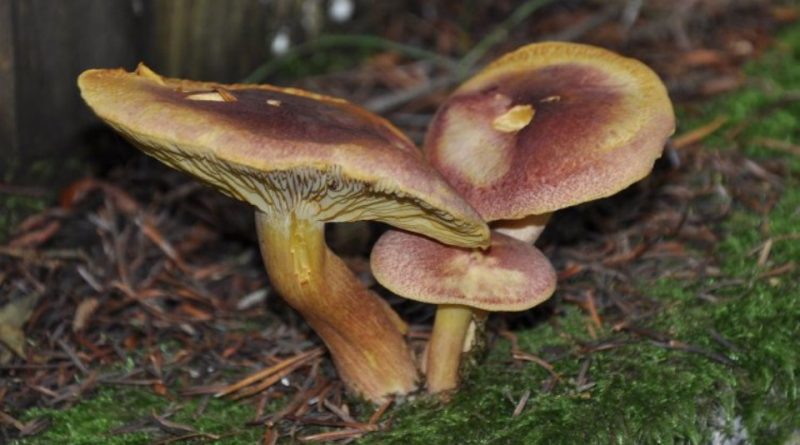Tricholomopsis rutilans
Tricholomopsis rutilans
Tricholomopsis rutilans (Tricholomopsis rutilans (Schaeff.) Singer, 1939) is a basidiomycete fungus belonging to the Tricholomataceae family.
Systematics –
From the systematic point of view it belongs to the Eukaryota Domain, Fungi Kingdom, Basidiomycota Division, Basidiomycetes Class, Agaricales Order, Tricholomataceae Family and therefore to the Tricholomopsis Genus and to T. rutilans Species.
The terms are synonyms and obsolete binaries: Agaricus variegatus Scopoli (1772), Agaricus xerampelinus Scopoli (1772), Agaricus rutilans Schaeffer (1774), Agaricus aurantius Batsch (1783), Agaricus serratis Bolton (1788), Agaricus xerampelinus Sowerby (1796), Agaricus rutilans var. xerampelinus (Sowerby) Persoon (1801), Gymnopus rutilans (Schaeff.) Gray (1821), Tricholoma rutilans (Schaeff.) P. Kummer (1871), Cortinellus rutilans (Schaeff.) P. Karstem, Gyrophila rutilans (Schaeff.) Quèlet (1886), Tricholoma variegatum (Scop.) Saccardo (1887), Pleurotus rutilans (Schaeff,) Dumèe (1917), Tricholomopsis variegate (Scop.) Singer (1943), Tricholomopsis rutilans var. variegate (Scop.) Bon.
Etymology –
The term Tricholomopsis comes from the Greek ending òpsis, that is similar to a Tricholoma. The specific epithet rutilans derives from rútilo reddish, shining, shining like gold: bright yellow or orange red, shining, glowing.
Geographical Distribution and Habitat –
Tricholomopsis rutilans is a fungus that grows in large groups on dead wood and on conifer stumps, especially pine, in the Mediterranean pine forests. Fruits from late summer to autumn and, in favorable seasons, until the beginning of winter.
Description –
This mushroom is recognized for having a hat 4–16 cm in diameter, fleshy, convex, bell-shaped, then expanded, often umbonate. The pileic surface is removable, dry, felted and dissociated into tiny triangular scales varying in color from lilacine purple to raspberry red, to vinous red or cyclamen red on a yellowish background, more evident towards the rim.
The lamellas are egg-yellow, dense, thin, attached.
The stem is 4-10 x 2.5 cm, yellow in color, cylindrical, first full then empty, sometimes covered with fluffy fluffy scales, especially towards the apex.
The flesh is pale yellow or creamy, compact, with a smell of soggy wood and a watery taste.
At the microscope we note ovoid spores, guttulate, white in mass, smooth, of 6-8 x 4.5-5.2 µm.
Cultivation –
Tricholomopsis rutilans is not a fungus cultivated also due to its poor edibility.
Uses and Traditions –
Tricholomopsis rutilans is an easy to identify fungus; the few other European species are T. decora (Fr.) Singer, of smaller size and with olive-yellow colorations also in the radial fibrils of the cap, T. flammula Mètrod, even smaller and has pile red-colored vinous, T. ornate. .) Singer, rare, tiny species with brown fulcrum on a pale olive-yellow background.
It is however a mediocre edible mushroom and therefore not recommended.
It is in fact one of the many non-edible lignicolous fungi or because unpleasant or even toxic, in this case it is a fibrous and decidedly bitter fungus. This mushroom is characterized by the great chromatic variability from orange to more or less intense violet, passing through many intermediate shades, always with vague vinous nuances.
Preparation Mode –
Tricholomopsis rutilans has no interest in food use due to its fibrous consistency and particularly bitter taste.
Guido Bissanti
Sources
– Wikipedia, the free encyclopedia.
– Cetto B., 2008. The mushrooms from life, Saturnia, Trento.
– Pignatti S., 1982. Flora of Italy, Edagricole, Bologna.
– Conti F., Abbate G., Alessandrini A., Blasi C. (edited by), 2005. An annotated checklist of the Italian vascular flora, Palombi Editore.
Attention: Pharmaceutical applications and food uses are indicated for informational purposes only, do not in any way represent a medical prescription; therefore no responsibility is assumed for their use for curative, aesthetic or food purposes.


